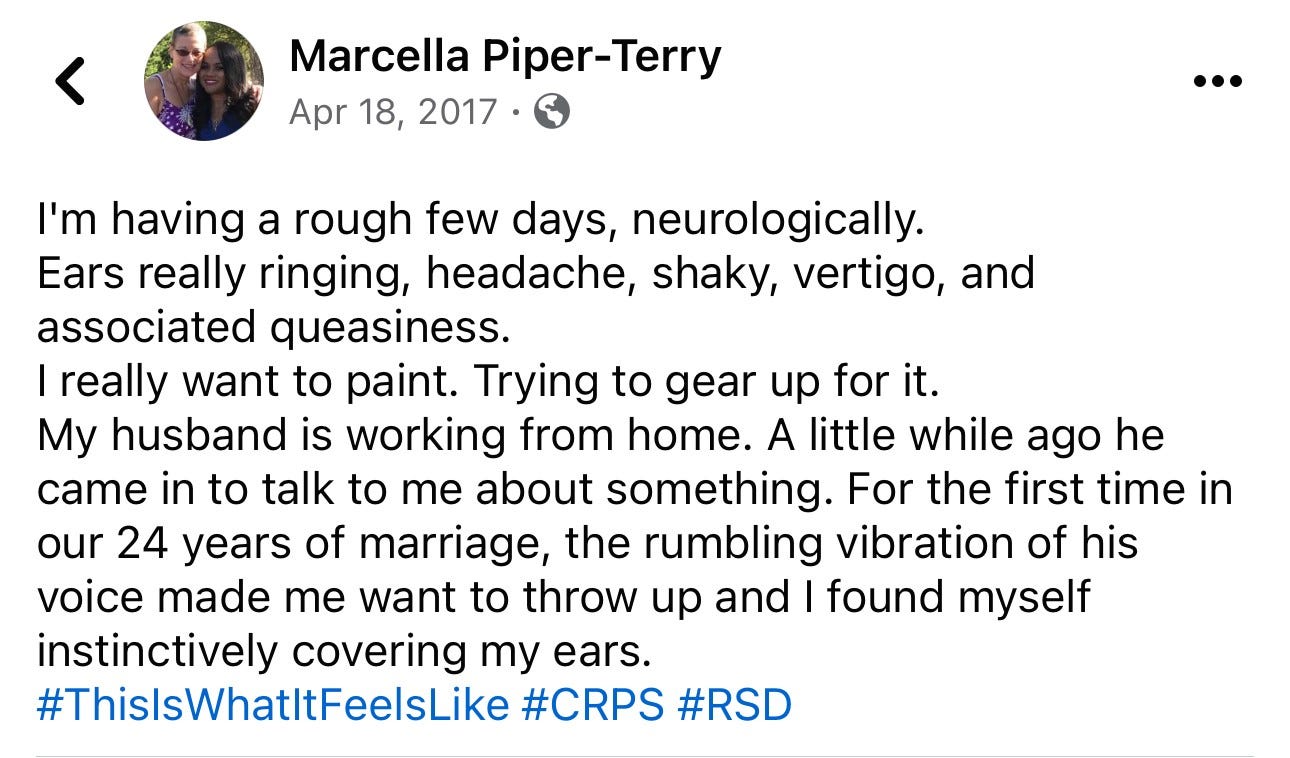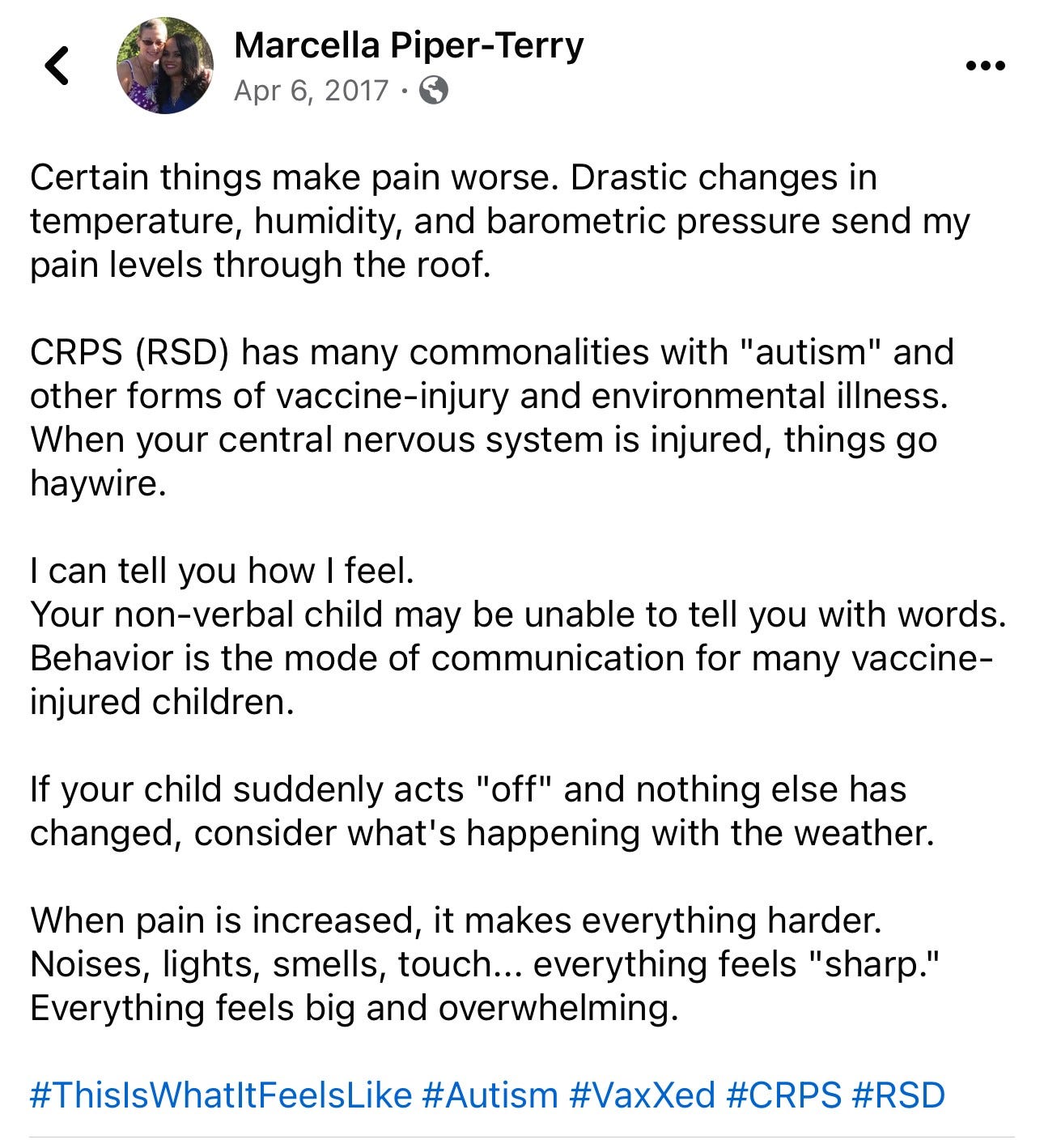CRPS, Chronic Pain, Fibromyalgia, Autism, and the link to COMT
How a TB test ruined my life, how I got it back, and what I learned in the process.
I have dealt with chronic pain for a long time. In January of 2010, I had a significant negative reaction to a TB test, which sent my inflammatory markers through the roof. Within three weeks of the test, I was in so much pain I could hardly walk. When I finally went to the doctor three months after the test, my rheumatoid factor (RF) was 253. The normal range is 0-14. My rheumatoid factor remained over 200 for the next 4 years. It has finally come down considerably and now hovers around 60 for the last few years.
In December of 2016, I was finally diagnosed correctly with CRPS - Complex Regional Pain Syndrome. That was definitely the right diagnosis, after many others, including chronic pain, fibromyalgia, antiphospholipid syndrome, and rheumatoid arthritis.
The following video, produced by the amazing Joshua Coleman, is from the Revolution for Truth Rally in Washington, D.C., which was held March 31, 2017. I almost didn’t make it to the event. I was struggling so much with cognitive issues (memory, organization, just being able to formulate a complete thought) that I was unable to write a speech at all. I almost canceled because I didn’t want to embarrass myself. At the time I believed there was a chance I would never be able to speak in public again, and I didn’t want the last time to be a disaster. Better to be remembered on a good note…
Side Note: In the video, I talk about advocacy and taking my angels with me wherever I go, relating the story of one of my trips to the Posey County Health Department on their Free Vaccine Day. Here is a picture of my stand outside the building:
2nd Side Note from the video: Mary Jo and Jose are the parents of Daniel Ramirez. Daniel was six years old when he died after receiving vaccines for kindergarten. I have not yet written up Daniel’s story here on Substack, but intend to ask Mary Jo to help me do that in the near future.
article continued…
I was very fortunate to receive effective treatment for CRPS from Dr. Katinka van der Merwe at Spero Clinic in Fayetteville, Arkansas. Ten weeks of intensive, daily treatment with multiple modalities including detox, diet, targeted supplements, specific frequency microcurrent, neuro-muscular reintegration, vagus nerve stimulation, neurolinguistic reprogramming, and meditation got me about 80% better. No more wheelchair. No more cane. And the things I learned in treatment allowed me to become my own therapist. I continued to improve after leaving treatment because I was able to apply many of the things I had learned on my own. Remission from CRPS continues now, seven years post-treatment. I am very grateful.
The ONLY reason I was able to obtain successful treatment for CRPS is because my good friends Jack (Dr. James Lyons Weiler) and Lisa Joyce Goes (aka “The Rev of The Thinking Moms Revolution) started a fund raiser for me and my friends and followers on Facebook generously donated to raise the money for treatment and expenses while I was in Fayetteville for ten weeks. If not for my friends, I would not have been able to do it. I cannot even imagine what my life might be like now if the path had been different.
Like most of the truly effective treatments for any chronic illness, insurance covers nothing. Mainstream medicine has no answers for CRPS, which is known as “the suicide disease” because the pain is so severe, and the medical community offers patients no hope.
What I learned in my journey through CRPS is that those of us who have been diagnosed with this monster have much in common with children on the autism spectrum. My experiences with gut dysfunction, inability to sleep, persistent hyperarousal, and hypersensitivity to environmental stimuli were crippling. I can recall one instance in particular, when I was in the waiting room of the psychologist who had been assigned to evaluate me for disability. My husband was with me, and I was in a wheelchair. It was a big room. There were two elevators across the room from me. I could hear every sound as they ascended and descended, the bells rang, the doors opened. I could hear the filter of the fish tank that was in the opposite corner of the room. I could hear every conversation at once. I could smell every smell, including the noxious smells coming from the stains in the carpet and the chemicals used to cover them up. I could hear the buzzing of the fluorescent lights and I still recall the pain in my eyes from the flickering. I lowered my head and tried to breathe into my sleeve. I felt nauseous. Things started spinning. I wanted to run out of the room. I wanted to get away.
There were times during the full throes of CRPS when the sound of my husband’s voice made me sick to my stomach - and not because of anything he said or did. It was the low vibration that I couldn’t handle. It sent me into fight-or-flight, and I would start shaking to the point where I had to lie down in a dark room with a weighted blanket.
As I look back on those years when I was so sick, and especially when I didn’t know what was wrong with me, I feel a myriad of emotions spanning from sadness and grief for the time lost with my family and the inability to work, to joy and gratitude for the recovery I have experienced and the life I now have. And for the lessons.
Links between CRPS and Autism…
The first thing I did after being accurately diagnosed was to share the news on my Facebook page. Within three hours of posting, there were five friends who shared that they had also been diagnosed with CRPS. CRPS is supposed to be rare. What this told me is that there is an over-abundance of CRPS in parents of vaccine-injured children. There is a link between CRPS and “autism.” Within a few hours, a long-time Facebook friend who is a chiropractor commented that she had a friend (also a chiropractor/functional medicine doctor) who specializes in the treatment of CRPS. She had written a book about it: Putting Out the Fire: New Hope for RSD/CRPS. My friend tagged Dr. van der Merwe in the comment. We started talking via messenger. I ordered the book. And within a week, the fundraiser was started.
The above photo is Dr. Katinka van der Merwe and me, during my initial visit to Spero Clinic in Fayetteville.
One of the first things I learned from Dr. Katinka’s book is that among people diagnosed with CRPS, there is a very high prevalence of certain genetic single nucleotide polymorphisms (SNPs). CRPS patients very often carry mutations on MTHFR and COMT. Just like people diagnosed with “autism.”
The experience of having CRPS gave me a glimpse of what our children endure.
I am compound heterozygous MTHFR (+/- on both c677t and a1298c) and homozygous (+/+) COMT. So is my daughter. I know what happened to her after vaccines. I know what happened to me after the TB test (which is basically the same as a vaccine, injecting disease matter, mercury [at the time I got mine], and formaldehyde into the body). When I got to the clinic in Fayetteville, I started talking to others there and found similar links in many cases. Gardasil and Hepatitis B vaccines were particularly implicated in the people I spoke with. I also had my first experience with vagus nerve stimulation and was over-the-moon excited when my pain level dropped drastically, indicating that I would be a good candidate for treatment.
One of the things that has been very difficult for me since attaining remission status is that there are many, many people who really need effective treatment and who lack the financial resources to obtain it. My reason for writing this post today is because I received an email this morning from Livewello. It was about COMT and Chronic Pain. I wanted to share it with my readers, in hopes the information and supplement recommendations at the end are helpful to anyone who is suffering from chronic pain. In my experience and through my own research, I can say that the recommendations are solid.
Here is the article:
COMT and Chronic Pain Susceptibility
Chronic pain affects over 50 million Americans, making it one of the most common reasons adults seek medical care. The causes behind chronic pain syndromes like fibromyalgia, migraines, and irritable bowel syndrome have long mystified doctors. While these conditions seem unrelated, emerging research reveals they may share common genetic factors that influence pain perception.
Studies show genetics accounts for 50% of an individual's pain sensitivity. The main player is the COMT gene which codes for the COMT enzyme that degrades brain chemicals like dopamine and norepinephrine. The most studied COMT variant is Val158Met. Those with Val/Val experience less pain while Met/Met individuals have higher pain sensitivity.
Up to 75% of fibromyalgia patients carry the Met/Met variant. This COMT phenotype is also prevalent among people with migraines and irritable bowel syndrome, which frequently overlap with fibromyalgia. The COMT connection likely explains why these conditions often co-occur.
How does COMT lead to chronic pain? The Met/Met variant is associated with substantially higher dopamine and norepinephrine levels in the brain and body. This amplifies pain signals and leads to central sensitization over time, characteristic of many chronic pain disorders.
Other genes linked to heightened pain perception include those affecting the brain's natural opioid system, the major neurotransmitter GABA, and inflammatory cytokines. While COMT may increase susceptibility, development of chronic pain requires a combination of genetic and lifestyle factors like injury, stress, and poor sleep habits.
Recent research found the Val158Met polymorphism accounts for about 10% of variability in pain sensitivity - meaningful but showing genetics are just one piece of the puzzle.
Though less studied, other gene variants like those regulating serotonin and endocannabinoids also influence pain perception and may interact with COMT.
Brain imaging studies show Met/Met individuals have differences in how their brains process pain signals from the body. This neural signature may serve as a biomarker.
While most studies focus on chronic pain in adults, there is emerging research on genetic factors in pediatric pain disorders like juvenile fibromyalgia.
Some pain researchers argue personalized genetic testing may one day guide treatment, allowing doctors to predict who will respond best to specific pain medications based on genotype.
Pharmaceutical companies are investigating new COMT-inhibiting drugs tailored to pain type and genetic profile to minimize side effects.
Larger genome-wide association studies may uncover new genetic variations involved in pain and explain why some with high-risk variants stay pain-free.
The epigenetics of pain is a new avenue of research, examining how genes are turned on/off by environmental stimuli and life experiences.
Though our genes do not define our destiny, understanding one's pain genetics can guide therapy. Relaxation techniques like meditation help lower catecholamine levels in Met/Met individuals. Some research indicates COMT inhibitors may benefit chronic pain, though more studies are needed. Diet and lifestyle changes can also optimize brain chemistry.
Knowledge of our biological risks empowers us to make informed choices and live well despite our genes.
Related Supplements
Here are some dietary supplements related to the content in this report. Click the shopping cart to purchase the supplement from our partners.
Shown to inhibit COMT activity and increase dopamine levels in the brain. Also has anti-inflammatory effects.
Omega-3 fatty acids (fish oil):
May reduce inflammation that contributes to pain. Also may protect neurons that use dopamine.
Required for COMT enzymatic reactions. Supplements may help for those deficient.
Herb that may inhibit COMT, especially in the Met/Met genotype. May prolong dopamine effects.
Supplement that provides methyl groups needed for COMT methylation reactions. May support COMT function.
Natural anti-inflammatory that may reduce inflammatory pain. Also thought to interact with neurotransmitter systems.
Compound found in hot chili peppers that depletes substance P, a neurotransmitter involved in pain signaling.
Herbal anxiolytic that may increase GABA, a neurotransmitter associated with reduced pain perception.
Herb that may inhibit COMT activity similar to some pain medications. Also boosts serotonin which improves mood.
Menthol is a COMT inhibitor. Peppermint oil applied topically may enhance painkilling dopamine effects.
Anti-inflammatory herb that may disrupt cytokine signaling implicated in pain hypersensitivity.
Compound from cannabis that affects endocannabinoid receptors involved in pain processing.
Supplement containing amino acids that may prevent breakdown of endorphins for natural pain relief.
Supplement that increases serotonin levels which may help with fibromyalgia and comorbid depression.
Contains anti-inflammatory gingerols that may inhibit pain-causing prostaglandins and leukotrienes.
Homeopathic pain remedy used topically that may reduce inflammation and impact serotonin.
End of Livewello article.
Note from Marcella: I am often asked about alternatives to the TB (Mantoux) test. At the time when I got mine, it was because I was in a graduate program, and it was mandatory at the university I was attending. I knew enough to get a religious exemption from vaccines, but I had never looked into the TB test and didn’t know what was being injected. I can be a slow learner sometimes. What I have learned through talking with others and sharing my story is that there is a huge misperception that the TB test is “safe.” It is so frequently used and without any thought of complications… just like vaccines.
Alternatives to the TB test include:
Chest x-ray - lots of problems here if you have to have them repeatedly
QuantiFERON-TB Gold Test - this is a blood draw. It is more sensitive and objective than the Mantoux test, and it does not inject anything into the patient. There are options to order the test without the need for a doctor’s prescription. This is one. (No affiliation or recommendation - just information.)
Final thoughts…
If you or someone you love has been diagnosed with CRPS, I urge you to order Dr. Katinka’s book, Putting Out the Fire: New Hope for RSD/CRPS. It was the first thing to give me hope in many years. Hope is essential for healing. Never let it go. I would also urge you to do everything within your power to pursue effective treatment and do it as soon as possible. The longer you wait, the harder it is to reverse the damage. Before I went for treatment, my biggest fear was that I would not be able to raise the necessary funds. If you are in that situation, let me say that from my perspective now, there is nothing I would not do to make it happen. This is one where, if you have equity in your home, it’s time to use it. If you have a 401k, it’s time to cash in.
Your life is waiting for you.
Me. Hiking in The Valley of Fire, February 2018.
Me with Tanner. Hiking in Colorado, Summer of 2019.
Dancing with my husband, Steve. February of 2022.
Recovery is possible. When mainstream medicine says there is nothing that can be done, that’s bullshit. Just because they don’t know what to do does not mean there is nothing that can be done.












Would really like to know more about the TB test.
I'm so glad you got better. You are such a blessing.